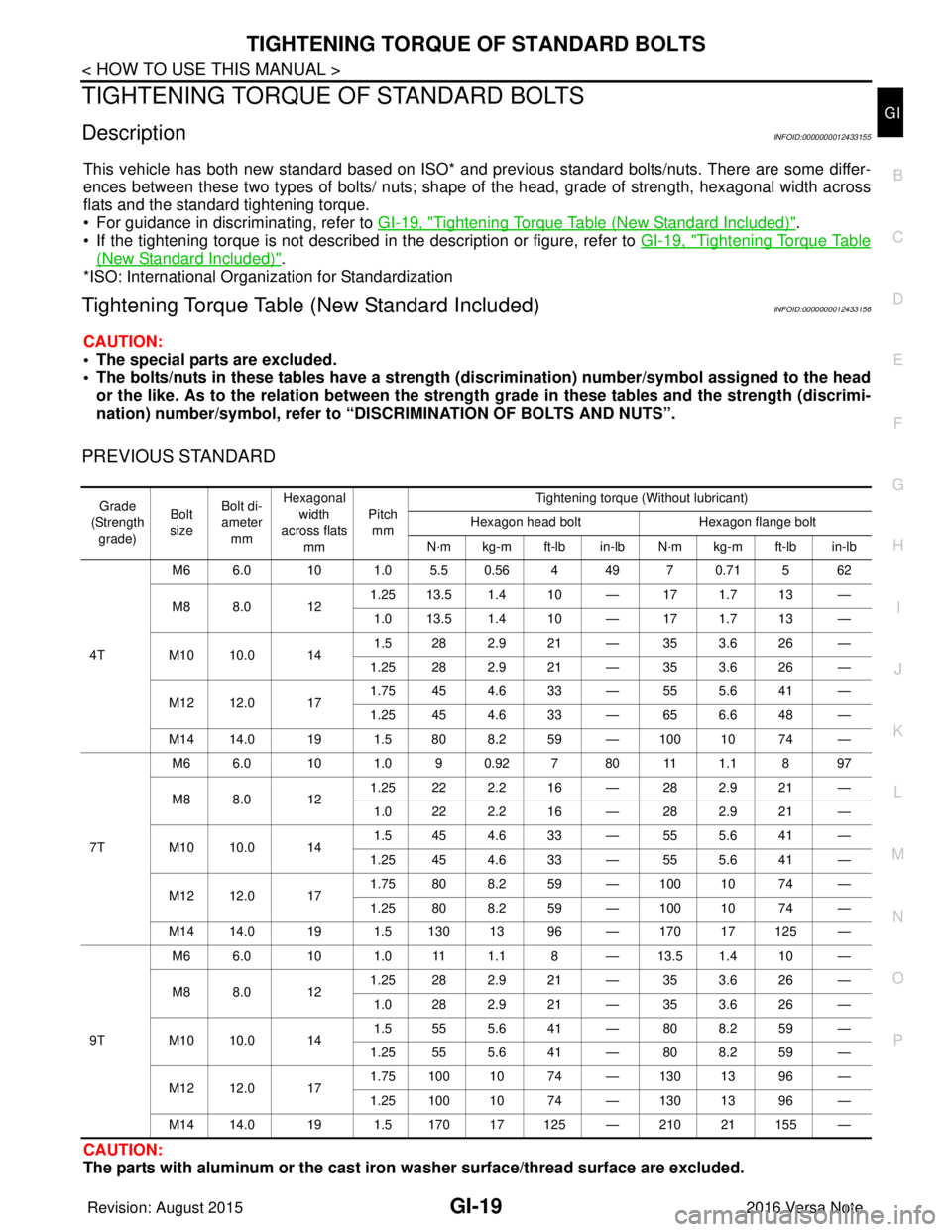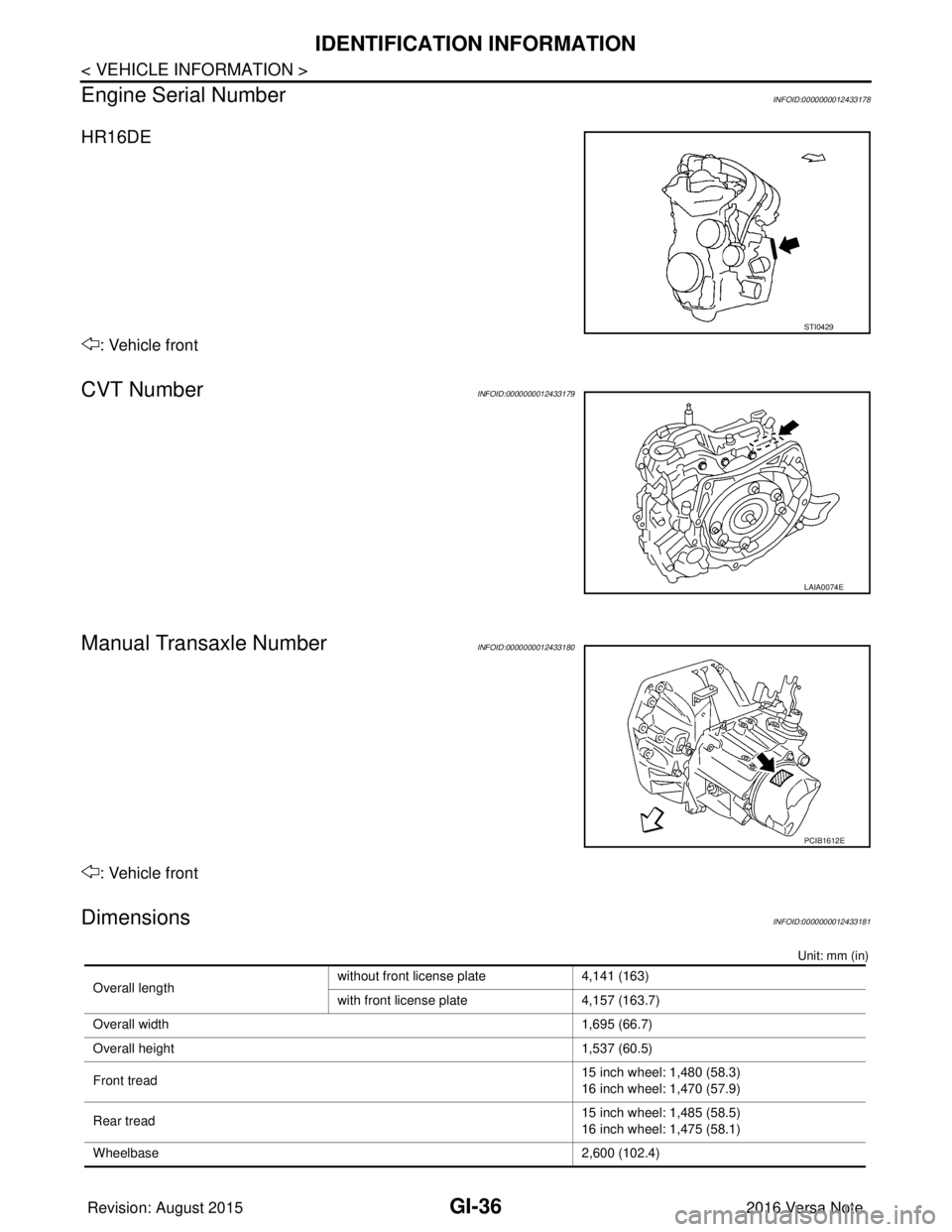2016 NISSAN NOTE width
[x] Cancel search: widthPage 1189 of 3641
![NISSAN NOTE 2016 Service Repair Manual EC-62
< SYSTEM DESCRIPTION >[HR16DE]
DIAGNOSIS SYSTEM (ECM)
MAS A/F SE-B1
VThe signal voltage of the mass air flow sensor is dis-
played. • When the engine is stopped, a certain
value is indicated. NISSAN NOTE 2016 Service Repair Manual EC-62
< SYSTEM DESCRIPTION >[HR16DE]
DIAGNOSIS SYSTEM (ECM)
MAS A/F SE-B1
VThe signal voltage of the mass air flow sensor is dis-
played. • When the engine is stopped, a certain
value is indicated.](/manual-img/5/57363/w960_57363-1188.png)
EC-62
< SYSTEM DESCRIPTION >[HR16DE]
DIAGNOSIS SYSTEM (ECM)
MAS A/F SE-B1
VThe signal voltage of the mass air flow sensor is dis-
played. • When the engine is stopped, a certain
value is indicated.
• When engine is running, specification range is indica ted in “SPEC”.
B/FUEL SCHDL ms“Base fuel schedule” indicates the fuel injection
pulse width programmed into ECM, prior to any
learned on board correction. When engine is running, specification
range is indicated in “SPEC”.
A/F ALPHA-B1 %The mean value of the air-fuel ratio feedback cor-
rection factor per cycle is indicated. • When the engine is stopped, a certain
value is indicated.
• When engine is running, specification
range is indica ted in “SPEC”.
• This data also includes the data for the air-fuel ratio learning control.
COOLAN TEMP/S °C or °F The engine coolant temperature (determined by the
signal voltage of the engine coolant temperature
sensor) is displayed. When the engine coolant temperature
sensor is open or short-circuited, ECM
enters fail-safe mode. The engine cool-
ant temperature determined by the ECM
is displayed.
A/F SEN1 (B1) VThe A/F signal computed from the input signal of
the air fuel ratio (A/F) sensor 1 is displayed.
HO2S2 (B1) VThe signal voltage of the heated oxygen sensor 2 is
displayed.
HO2S2 MNTR(B1) RICH/LEAN • Display of heated oxygen sensor 2 signal.
- RICH: means the amount of oxygen after three
way catalyst is relatively small.
- LEAN: means the amount of oxygen after three
way catalyst is relatively large. When the engine is stopped, a certain
value is indicated.
VHCL SPEED SE km/h or mph The vehicle speed computed from the vehicle
speed signal sent from combination meter is dis-
played.
BATTERY VOLT V The power supply voltage of ECM is displayed.
ACCEL SEN 1 VThe accelerator pedal position sensor signal volt-
age is displayed. ACCEL SEN 2 signal is converted by
ECM internally. Thus, it differs from
ECM terminal voltage signal.
ACCEL SEN 2
TP SEN 1-B1
VThe throttle position sensor signal voltage is dis-
played. TP SEN 2-B1 signal is converted by
ECM internally. Thus, it differs from
ECM terminal voltage signal.
TP SEN 2-B1
FUEL T/TMP SE
°C or °F The fuel temperature (determined by the signal volt-
age of the fuel tank temperature sensor) is dis-
played.
EVAP SYS PRES VThe signal voltage of EVAP control system pres-
sure sensor is displayed.
FUEL LEVEL SE VThe signal voltage of the fuel level sensor is dis-
played.
START SIGNAL ON/OFF Indicates start signal status [ON/OFF] computed by
the ECM according to the signals of engine speed
and battery voltage. After starting the engine, [OFF] is dis-
played regardless of the starter signal.
CLSD THL POS ON/OFF Indicates idle position [ON/OFF] computed by ECM
according to the accelerator pedal position sensor
signal.
AIR COND SIG ON/OFF Indicates [ON/OFF] condition of the air conditioner
switch as determined by the air conditioner signal.
PW/ST SIGNAL ON/OFF [ON/OFF] condition of the power steering system
(determined by the signal sent from EPS control
unit) is indicated.
Monitored item Unit
DescriptionRemarks
Revision: August 2015 2016 Versa Note
cardiagn.com
Page 1190 of 3641
![NISSAN NOTE 2016 Service Repair Manual DIAGNOSIS SYSTEM (ECM)EC-63
< SYSTEM DESCRIPTION > [HR16DE]
C
D
E
F
G H
I
J
K L
M A
EC
NP
OLOAD SIGNAL ON/OFF
• Indicates [ON/OFF] condition of the electrical
lode signal.
- ON: Rear window defogge NISSAN NOTE 2016 Service Repair Manual DIAGNOSIS SYSTEM (ECM)EC-63
< SYSTEM DESCRIPTION > [HR16DE]
C
D
E
F
G H
I
J
K L
M A
EC
NP
OLOAD SIGNAL ON/OFF
• Indicates [ON/OFF] condition of the electrical
lode signal.
- ON: Rear window defogge](/manual-img/5/57363/w960_57363-1189.png)
DIAGNOSIS SYSTEM (ECM)EC-63
< SYSTEM DESCRIPTION > [HR16DE]
C
D
E
F
G H
I
J
K L
M A
EC
NP
OLOAD SIGNAL ON/OFF
• Indicates [ON/OFF] condition of the electrical
lode signal.
- ON: Rear window defogger switch is ON and/or lighting switch is 2nd position.
- OFF: Both rear window defogger switch and light-
ing switch are OFF.
IGNITION SW ON/OFFIndicates [ON/OFF] condition from ignition switch
signal.
HEATER FAN SW ON/OFF Indicates [ON/OFF] condition from the heater fan
switch signal.
BRAKE SW ON/OFFIndicates [ON/OFF] condition from the stop lamp
switch signal.
INJ PULSE-B1 msecIndicates the actual fuel injection pulse width com-
pensated by ECM according to the input signals. When the engine is stopped, a certain
computed value is indicated.
IGN TIMING BTDCIndicates the ignition timing computed by ECM ac-
cording to the input signals. When the engine is stopped, a certain
value is indicated.
CAL/LD VALUE %“Calculated load value” indicates the value of the
current air flow divided by peak air flow.
MASS AIRFLOW g/sIndicates the mass air flow computed by ECM ac-
cording to the signal voltage of the mass air flow
sensor.
PURG VOL C/V %• Indicates the EVAP canister purge volume con-
trol solenoid valve control value computed by the
ECM according to the input signals.
• The opening becomes larger as the value in-
creases.
INT/V TIM(B1) °CA Indicates [ °CA] of intake camshaft advance angle.
EXH/V TIM B1 °CA Indicates [ °CA] of exhaust camshaft retard angle.
INT/V SOL(B1) %• The control value of the intake valve timing con-
trol solenoid valve (determined by ECM accord-
ing to the input signals) is indicated.
• The advance angle becomes larger as the value increases.
AIR COND RLY ON/OFF The air conditioner relay control condition (deter-
mined by ECM according to the input signals) is in-
dicated.
FUEL PUMP RLY ON/OFF Indicates the fuel pump relay control condition de-
termined by ECM according to the input signals.
VENT CONT/V ON/OFF • The control condition of the EVAP canister vent
control valve (determined by ECM according to
the input signals) is displayed.
- ON: Closed
-OFF: Open
THRTL RELAY ON/OFF Indicates the throttle control motor relay control
condition determined by the ECM according to the
input signals.
COOLING FAN HI/LOW/OFF • Indicates the condition of the cooling fan (deter-
mined by ECM according to the input signals).
- HI: High speed operation
- LOW: Low speed operation
-OFF: Stop
HO2S2 HTR (B1) ON/OFF Indicates [ON/OFF] condition of heated oxygen
sensor 2 heater determined by ECM according to
the input signals.
Monitored item Unit
DescriptionRemarks
Revision: August 2015 2016 Versa Note
cardiagn.com
Page 1278 of 3641
![NISSAN NOTE 2016 Service Repair Manual TROUBLE DIAGNOSIS - SPECIFICATION VALUEEC-151
< DTC/CIRCUIT DIAGNOSIS > [HR16DE]
C
D
E
F
G H
I
J
K L
M A
EC
NP
O
DTC/CIRCUIT DIAGNOSIS
TROUBLE DIAGNOSIS - SPECIFICATION VALUE
DescriptionINFOID:0000000 NISSAN NOTE 2016 Service Repair Manual TROUBLE DIAGNOSIS - SPECIFICATION VALUEEC-151
< DTC/CIRCUIT DIAGNOSIS > [HR16DE]
C
D
E
F
G H
I
J
K L
M A
EC
NP
O
DTC/CIRCUIT DIAGNOSIS
TROUBLE DIAGNOSIS - SPECIFICATION VALUE
DescriptionINFOID:0000000](/manual-img/5/57363/w960_57363-1277.png)
TROUBLE DIAGNOSIS - SPECIFICATION VALUEEC-151
< DTC/CIRCUIT DIAGNOSIS > [HR16DE]
C
D
E
F
G H
I
J
K L
M A
EC
NP
O
DTC/CIRCUIT DIAGNOSIS
TROUBLE DIAGNOSIS - SPECIFICATION VALUE
DescriptionINFOID:0000000012431370
The specification (SP) value indicates the tolerance of
the value that is displayed in “SPEC” of “DATA MONI-
TOR” mode of CONSULT during normal operation of the Engine Control System. When the value in “SPEC” of
“DATA MONITOR” mode is within the SP value, the Engine Control System is confirmed OK. When the value
in “SPEC” of “DATA MONITOR” mode is NOT within the SP value, the Engine Control System may have one
or more malfunctions.
The SP value is used to detect malfunctions that may af fect the Engine Control System, but will not light the
MIL.
The SP value will be displayed for the following three items:
• B/FUEL SCHDL (The fuel injection pulse width programmed into ECM prior to any learned on board correc- tion)
• A/F ALPHA-B1 (The mean value of air-fuel ratio feedback correction factor per cycle)
• MAS A/F SE-B1 (The signal voltage of the mass air flow sensor)
Component Function CheckINFOID:0000000012431371
1.START
Make sure that all of the following conditions are satisfied.
• Vehicle driven distance: More than 5,000 km (3,107 miles)
• Barometric pressure: 98.3 - 104.3 kPa (1.003 - 1.064 kg/cm
2, 14.25 - 15.12 psi)
• Atmospheric temperature: 20 - 30 °C (68 - 86° F)
• Engine coolant temperature: 75 - 95 °C (167 - 203° F)
• Transmission: Warmed-up
- CVT models: After the engine is warmed up to normal operating temperature, drive vehicle until “FLUID TEMP SE” (CVT fluid temperature sensor signal) indicates more than 60 °C (140° F).
- M/T models: After the engine is warmed up to normal operating temperature, drive vehicle for 5 minutes.
• Electrical load: Not applied
- Rear window defogger switch, air conditioner switch, lighting switch are OFF. Steering wheel is straight
ahead.
• Engine speed: Idle
>> GO TO 2.
2.PERFORM “SPEC” OF “DATA MONITOR” MODE
With CONSULT
NOTE:
Perform “SPEC” in “DATA MONITOR” mode in maximum scale display.
1. Perform EC-133, "
Work Procedure".
2. Select “B/FUEL SCHDL”, “A/F ALPHA-B1” and “MAS A/F SE-B1” in “SPEC” of “DATA MONITOR” mode
with CONSULT.
3. Make sure that monitor items are within the SP value.
Is the inspection result normal?
YES >> END
NO >> Go to EC-152, "
Diagnosis Procedure".
Revision: August 2015 2016 Versa Note
cardiagn.com
Page 1905 of 3641

ABBREVIATIONSGI-17
< HOW TO USE THIS MANUAL >
C
DE
F
G H
I
J
K L
M B
GI
N
O P
O
P
R
S
T
ABBREVIATION DESCRIPTION
O2 Oxygen
O2S Oxygen sensor
OBD On board diagnostic
OC Oxidation catalytic converter
OD Overdrive
OL Open loop
OSS Output shaft speed
ABBREVIATION DESCRIPTION
P/S Power steering
PBR Potentio balance resistor
PCV Positive crankcase ventilation
PNP Park/Neutral position
PSP Power steering pressure
PTC Positive temperature coefficient
PTO Power takeoff
PWM Pulse width modulation
ABBREVIATION DESCRIPTION
RAM Random access memory
RAS Rear active steer
RH Right-hand
RHD Right-hand drive
ROM Read only memory
RPM Engine speed
RR Rear
ABBREVIATION DESCRIPTION
SAE Society of Automoti ve Engineers, Inc.
SCK Serial clock
SDS Service Data and Specifications
SRT System readiness test
SST Special Service Tools
ABBREVIATION DESCRIPTION
TC Turbocharger
TCM Transmission control module
TCS Traction control system
TCU Telematics communication unit
TP Throttle position
TPMS Tire pressure monitoring system TSS Turbine shaft speed
TWC Three way catalytic converter
Revision: August 2015 2016 Versa Note
cardiagn.com
Page 1907 of 3641

TIGHTENING TORQUE OF STANDARD BOLTSGI-19
< HOW TO USE THIS MANUAL >
C
DE
F
G H
I
J
K L
M B
GI
N
O PTIGHTENING TORQUE OF STANDARD BOLTS
DescriptionINFOID:0000000012433155
This vehicle has both new standard based on ISO* and prev ious standard bolts/nuts. There are some differ-
ences between these two types of bolts/ nuts; shape of the head, grade of strength, hexagonal width across
flats and the standard tightening torque.
• For guidance in discriminating, refer to GI-19, "
Tightening Torque Table (New Standard Included)".
• If the tightening torque is not described in the description or figure, refer to GI-19, "
Tightening Torque Table
(New Standard Included)".
*ISO: International Organization for Standardization
Tightening Torque Table (New Standard Included)INFOID:0000000012433156
CAUTION:
• The special parts are excluded.
• The bolts/nuts in these tables have a strength (discrimination) number/sym bol assigned to the head
or the like. As to the relation between the streng th grade in these tables and the strength (discrimi-
nation) number/symbol, refer to “DISCRIMINATION OF BOLTS AND NUTS”.
PREVIOUS STANDARD
CAUTION:
The parts with aluminum or the cast iron washer surface/thread surface are excluded.
Grade
(Strength
grade) Bolt
size Bolt di-
ameter
mm Hexagonal
width
across flats mm Pitch
mm Tightening torque (Without lubricant)
Hexagon head bolt Hexagon flange bolt
N·m kg-m ft-lb in-lb N·m kg-m ft-lb in-lb
4T M6 6.0 10 1.05.50.564 49 70.715 62
M8 8.0 12
1.25 13.5 1.4 10 — 17 1.7 13 —
1.0 13.5 1.4 10 — 17 1.7 13 —
M10 10.0 14 1.5282.921 — 353.626 —
1.25 28 2.9 21 — 35 3.6 26 —
M12 12.0 17 1.75 45 4.6 33 — 55 5.6 41 —
1.25 45 4.6 33 — 65 6.6 48 —
M14 14.0 19 1.5 80 8.2 59 — 100 10 74 —
7T M6 6.0 10 1.0 9 0.92 7 80 11 1.1 8 97
M8 8.0 12
1.25 22 2.2 16 — 28 2.9 21 —
1.0222.216 — 282.921 —
M10 10.0 14 1.5454.633 — 555.641 —
1.25 45 4.6 33 — 55 5.6 41 —
M12 12.0 17 1.75 80 8.2 59 — 100 10 74 —
1.25 80 8.2 59 — 100 10 74 —
M1414.0 19 1.513013 96 — 17017125 —
9T M6 6.0 10 1.0 11 1.1 8 — 13.5 1.4 10 —
M8 8.0 12
1.25 28 2.9 21 — 35 3.6 26 —
1.0282.921 — 353.626 —
M10 10.0 14 1.5555.641 — 808.259 —
1.25 55 5.6 41 — 80 8.2 59 —
M12 12.0 17 1.75 100 10 74 — 130 13 96 —
1.25 100 10 74 — 130 13 96 —
M14 14.0 19 1.5 170 17 125 — 210 21 155 —
Revision: August 2015 2016 Versa Note
cardiagn.com
Page 1908 of 3641

GI-20
< HOW TO USE THIS MANUAL >
TIGHTENING TORQUE OF STANDARD BOLTS
NEW STANDARD BASED ON ISO
CAUTION:
1. Use tightening torque with lubricant for the new standard bolts/nuts in principle. Friction coeffi-cient stabilizer is applied to the new standard bolts/nuts.
2. However, use tightening torque without lubricant for the foll owing cases. Friction coefficient stabi-
lizer is not applied to the following bolts/nuts.
- Grade 4.8, M6 size bolt, Co nical spring washer installed
- Paint removing nut (Size M6 an d M8) for fixing with weld bolt
Grade
(Strength grade) Bolt
size Bolt di-
ameter
mm Hexagonal
width
across flats
mm Pitch
mm Tightening torque
Hexagon head bolt Hexagon flange bolt
N·m kg-m ft-lb in-lb N·m kg-m ft-lb in-lb
4.8
(Without
lubricant) M6 6.0 10 1.0 5.5 0.56 4 49 7 0.71 5 62
M8 8.0 13
1.25 13.5 1.4 10 — 17 1.7 13 —
1.0 13.5 1.4 10 — 17 1.7 13 —
M10 10.0 16 1.5 282.921 — 353.626 —
1.25 28 2.9 21 — 35 3.6 26 —
M12 12.0 18 1.75 45 4.6 33 — 55 5.6 41 —
1.25 45 4.6 33 — 65 6.6 48 —
M14 14.0 21 1.5 80 8.2 59 — 100 10 74 —
4.8
(With lu-
bricant) M6 6.0 10 1.0 4 0.41 3 35 5.5 0.56 4 49
M8 8.0 13
1.25 11 1.1 8 — 13.5 1.4 10 —
1.0 11 1.1 8 — 13.5 1.4 10 —
M10 10.0 16 1.5 222.216 — 282.921 —
1.25 22 2.2 16 — 28 2.9 21 —
M12 12.0 18 1.75 35 3.6 26 — 45 4.6 33 —
1.25 35 3.6 26 — 45 4.6 33 —
M14 14.0 21 1.5 65 6.6 48 — 80 8.2 59 —
8.8
(With lu-
bricant) M6 6.0 10 1.0 8 0.82 6 71 10 1.0 7 89
M8 8.0 13
1.25 21 2.1 15 — 25 2.6 18 —
1.0 212.115 — 252.618 —
M10 10.0 16 1.5 404.130 — 505.137 —
1.25 40 4.1 30 — 50 5.1 37 —
M12 12.0 18 1.75 70 7.1 52 — 85 8.7 63 —
1.25 70 7.1 52 — 85 8.7 63 —
M14 14.0 21 1.5 120 12 89 — 140 14 103 —
10.9
(With lu-
bricant) M6 6.0 10 1.0 10 1.0 7 89 12 1.2 9 106
M8 8.0 13
1.25 27 2.8 20 — 32 3.3 24 —
1.0 272.820 — 323.324 —
M10 10.0 16 1.5 555.641 — 656.648 —
1.25 55 5.6 41 — 65 6.6 48 —
M12 12.0 18 1.75 95 9.7 70 — 110 11 81 —
1.25 95 9.7 70 — 110 11 81 —
M14 14.0 21 1.5 160 16 118 — 180 18 133 —
Revision: August 2015 2016 Versa Note
cardiagn.com
Page 1924 of 3641

GI-36
< VEHICLE INFORMATION >
IDENTIFICATION INFORMATION
Engine Serial Number
INFOID:0000000012433178
HR16DE
: Vehicle front
CVT NumberINFOID:0000000012433179
Manual Transaxle NumberINFOID:0000000012433180
: Vehicle front
DimensionsINFOID:0000000012433181
Unit: mm (in)
STI0429
LAIA0074E
PCIB1612E
Overall length without front license plate 4,141 (163)
with front license plate
4,157 (163.7)
Overall width 1,695 (66.7)
Overall height 1,537 (60.5)
Front tread 15 inch wheel: 1,480 (58.3)
16 inch wheel: 1,470 (57.9)
Rear tread 15 inch wheel: 1,485 (58.5)
16 inch wheel: 1,475 (58.1)
Wheelbase 2,600 (102.4)
Revision: August 2015 2016 Versa Note
cardiagn.com
Page 3312 of 3641
![NISSAN NOTE 2016 Service Repair Manual STRUCTURE AND OPERATIONTM-71
< SYSTEM DESCRIPTION > [CVT: RE0F11A]
C
EF
G H
I
J
K L
M A
B
TM
N
O P
Mechanism
It is composed of a pair of pulleys (the groove width is changed freely in the axial direct NISSAN NOTE 2016 Service Repair Manual STRUCTURE AND OPERATIONTM-71
< SYSTEM DESCRIPTION > [CVT: RE0F11A]
C
EF
G H
I
J
K L
M A
B
TM
N
O P
Mechanism
It is composed of a pair of pulleys (the groove width is changed freely in the axial direct](/manual-img/5/57363/w960_57363-3311.png)
STRUCTURE AND OPERATIONTM-71
< SYSTEM DESCRIPTION > [CVT: RE0F11A]
C
EF
G H
I
J
K L
M A
B
TM
N
O P
Mechanism
It is composed of a pair of pulleys (the groove width is changed freely in the axial direction) and the steel belt
(the steel plates are placed conti
nuously and the belt is guided with the multilayer steel rings on both sides).
The groove width changes according to wrapping radius of steel belt and pulley from low status to overdrive
status continuously with non-step. It is controlled with the oil pressures of primary pulley and secondary pulley.
Steel belt
It is composed of multiple steel plates (A) and two steel rings (B)
stacked to a several number. The feature of this steel belt transmits
power with compression of the steel plate in contrast with transmis-
sion of power in pulling with a rubber belt. Friction force is required
with the pulley slope to transmit power from the steel plate. The force
is generated with the following mechanism:
Oil pressure applies to the secondary pulley to nip the plate. ⇒The
plate is pushed and extended outward. ⇒The steel ring shows with-
stands. ⇒Pulling force is generated on the steel ring. ⇒ The plate of
the primary pulley is nipped between the pulley. ⇒Friction force is
generated between the steel belt and the pulley.
Therefore, responsibilities are divided by the steel plate that trans-
mits the power with compression and the steel ring that main tains necessary friction force. In this way, the
tension of the steel ring is distributed on the entire su rface and stress variation is limited, resulting in good
durability.
Pulley
The primary pulley (input shaft side) and the secondary pulley (output shaft side) have the shaft with slope
(fixed cone surface), movable sheave (movable cone surface that can move in the axial direction) and oil pres-
sure chamber at the back of the movable sheave.
Pulley gear shifting operation
• Pulley gear shifting operation The movable sheave slides on the shaft to change the groove width of the pulley. Input signals of engine
load (accelerator pedal opening), engine revolution and gear ratio (vehicle speed) change the operation
pressures of the primary pulley and the secondary pulle y, and controls the pulley groove width. Along with
change of the pulley groove width, the belt contact radi us is changed. This allows continuous and stepless
JSDIA1966ZZ
JSDIA1779GB
Revision: August 2015 2016 Versa Note
cardiagn.com